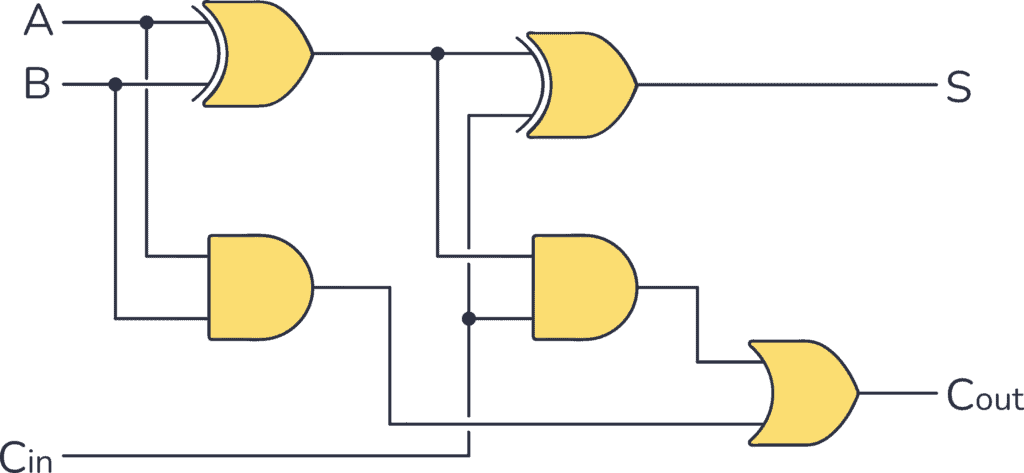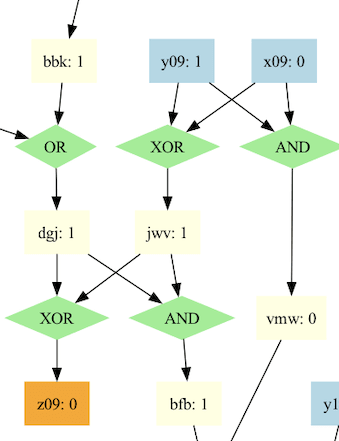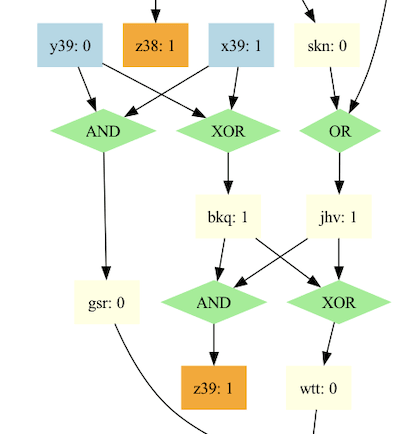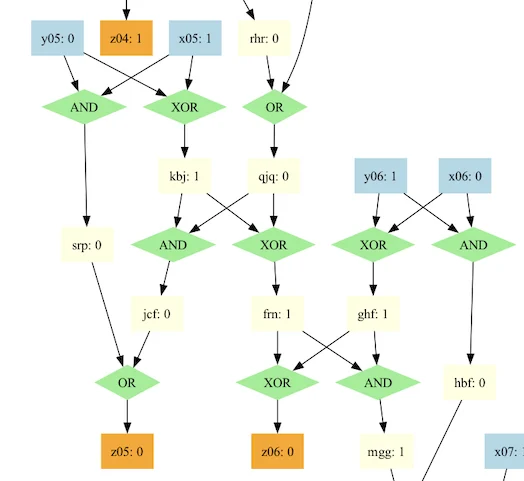Adder Circuits in the Jungle

We're almost at the end of the journey for this year, and as per tradition, the closer you get to 25 the more the complexity of the puzzles increases.
Of course, this day was no exception, and at this point it is reasonable to say that "Day 24: Crossed Wires" was the most difficult challenge of all to solve.
The input for today's puzzle is composed as follows:
- a list of wires named
x00throughxNandy00throughyN - a list of logic operations featuring either
AND,ORorXOR
x00: 1
x01: 1
x02: 1
y00: 0
y01: 1
y02: 0
x00 AND y00 -> z00
x01 XOR y01 -> z01
x02 OR y02 -> z02
The larger example we're given and the real input include not only logical gates with x and y, but also others such as
ntg XOR fgs -> mjb
y02 OR x01 -> tnw
gnj AND wpb -> z02
First things first, we need to solve all the logic gates and eventually obtain the values for the wires named z00 through zN. In fact, the z wires form a binary number, obtained combining the bits from zN to z00 (which is the least significant bit):
z00: 0
z01: 0
z02: 0
z03: 1
z04: 0
z05: 1
z06: 1
z07: 1
z08: 1
z09: 1
z10: 1
z11: 0
z12: 0
=> 0011111101000
The answer is the decimal equivalent (2024 in the example above) of the binary number formed by the z bits.
In order to keep things simple, I decided to split the logic in two.
Basically, first I solved all logical gates containing x and y wires on the left-hand side: solving a gate means finding the value of a wire, which I then added to the solvedGates map. Afterwards, I kept using the known wires to solve more and more gates, until the list of unsolvedGates was empty.
function findOutput(wires: Map<string, number>, gates: Map<string, Gate>) {
const solvedGates = new Map<string, number>();
const unsolvedGates = new Map(gates);
for (const [key, gate] of gates) {
const { wire1, wire2 } = gate;
if (
(wire1.startsWith('x') || wire1.startsWith('y')) &&
(wire2.startsWith('x') || wire2.startsWith('y'))
) {
unsolvedGates.delete(key);
solvedGates.set(key, calc(gate, wires));
}
}
while (unsolvedGates.size > 0) {
for (const [key, gate] of unsolvedGates) {
if (solvedGates.has(gate.wire1) && solvedGates.has(gate.wire2)) {
unsolvedGates.delete(key);
solvedGates.set(key, calc(gate, solvedGates));
}
}
}
return findNumberFromWires('z', solvedGates);
}
The findNumberFromWires function is also straightforward: we just need to find all wires starting with z from the list of solved gates, then sorting it by decreasing number, join them to a single binary number, and finally convert it to decimal:
function findNumberFromWires(id: string, wires: Map<string, number>) {
const zWires = new Map<number, number>();
for (const [key, value] of wires) {
if (key.startsWith(id)) {
const index = Number.parseInt(key.replace(id, ''));
zWires.set(index, value);
}
}
const result = Array.from(zWires)
.sort((a, b) => b[0] - a[0])
.map(([_, value]) => value)
.join('');
return Number.parseInt(result, 2);
}
Seeing how trivial the first part was all in all, I was genuinely worried at the thought of what part 2 would entail... and expectations were not disappointed :)
It turns out that the whole set of gate is a system to compute the sum of two binary numbers: essentially, the x00...xN wires represent a binary number; y00...yN are another binary number; z00...zN is the result of adding them, so x + y = z.
Now, the z binary number that was the answer for part 1 is not the sum of x and y according to our input. This is because our system of gates has a number of wires that have been swapped - 4 pairs to be exact. Our goal is to identify all such wires, so 8 wires in total, which sorted and combined as a comma-separated string will provide the answer to Part 2.
Feeling the panic yet? 😵💫
Well, I definitely felt it at the start; in fact it took me longer than I like to admit to wrap my head around the task and figure a strategy out.
During my research I saw that number of people on Reddit leveraged graphics tools like Graphviz, which I decided to use as well, and which definitely helped visualised this huge tangle of connected wires - quite literally.
The key here was to understand how adding binary number works in our system. Specifically, each bit of our final z number is computed via an adder circuit, which I attached below:

In a very simplified explanation, we start from X and Y and, thanks to some XOR, AND and OR magic, we get Z - and of course the operation takes into account any carry from the previous steps, and finally passes the carry over to the next one.
It follows that, since the sum Z is calculated incorrectly by the system, there are errors somewhere in the logic chain.
In fact, observing the graph plotted via Graphviz, we can notice a majority of correct adder circuits, like this:

... and a number of incorrect ones, like this with z39 being the result of an AND instead of a XOR 🤔

I mean, it's fairly easy to tell there's something wrong when spotting a circuit like this (notice z05 and frn):

I wanted, however, to write a formal algorithm to identify all such problems, instead of checking the graph circuit by circuit and taking notes of the various errors (knowing myself, I knew I was going to make stupid mistakes and waste a lot of time for nothing).
So, after a few attempts, here's the function I managed to put together that identifies all the swapped wires:
function findWiresToSwap(_: Map<string, number>, gates: Map<string, Gate>) {
const BIT_LENGTH = 45;
const incorrect: string[] = [];
const findGate = (wire1: string, wire2: string, op: string) =>
[...gates.entries()].find(
([_, g]) =>
((g.wire1 === wire1 && g.wire2 === wire2) ||
(g.wire1 === wire2 && g.wire2 === wire1)) &&
g.op === op
);
// Helper function to find a gate by wire connection
const findNextGate = (wire: string) =>
[...gates.entries()].find(
([_, g]) => g.wire1 === wire || g.wire2 === wire
);
for (let i = 0; i < BIT_LENGTH; i++) {
const id = i.toString().padStart(2, '0');
const wire1 = `x${id}`;
const wire2 = `y${id}`;
const xorGate = findGate(wire1, wire2, 'XOR');
const andGate = findGate(wire1, wire2, 'AND');
const zGateEntry = [...gates.entries()].find(
([key]) => key === `z${id}`
);
if (!xorGate || !andGate || !zGateEntry) continue;
const [xorKey] = xorGate;
const [andKey] = andGate;
const [zKey, zGate] = zGateEntry;
// All z nodes must be connected to a XOR
if (zGate.op !== 'XOR') {
incorrect.push(zKey);
}
// All AND gates must go to an OR (excluding the first case, which starts the carry flag)
const or = [...gates.entries()].find(
([_, g]) => g.wire1 === andKey || g.wire2 === andKey
);
if (or !== undefined) {
const [_, orGate] = or;
if (orGate.op !== 'OR' && i > 0) {
incorrect.push(andKey);
}
}
// The first XOR must go to XOR or AND
const next = findNextGate(xorKey);
if (next !== undefined) {
const [_, nextGate] = next;
if (nextGate.op === 'OR') {
incorrect.push(xorKey);
}
}
}
// All XOR nodes must be connected to an x, y, or z node
const wrongGates = [...gates.entries()]
.filter(
([key, g]) =>
!g.wire1[0].match(/[xy]/g) &&
!g.wire2[0].match(/[xy]/g) &&
!key[0].match(/z/g) &&
g.op === 'XOR'
)
.map(([key, _]) => key);
incorrect.push(...wrongGates);
return incorrect.sort().join(',');
}
Whew, after so much effort, it's parseInt(10, 2) more stars for us 😉